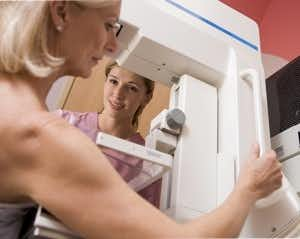
Here we go again. The mammogram debate has once again heated up because of new research (Canadian National Breast Screening Study) casting doubt on the value of this routine cancer screening technique. In a nutshell, roughly 90,000 women were randomized to receive a breast exam plus mammogram or only a breast exam. The goal of the study was to determine whether locating abnormalities before they were large enough to feel during a breast exam would save lives. The women were followed for up to 25 years. At the end of that timeframe, there was no discernible difference in deaths due to breast cancer between the two groups of women.
Here, in the investigators’ own words, were the results:
“During the entire study period, 3250 women in the mammography arm and 3133 in the control arm had a diagnosis of breast cancer, and 500 and 505, respectively, died of breast cancer. Thus the cumulative mortality from breast cancer was similar between women in the mammography arm and in the control arm.”
Their Conclusions:
“In conclusion, our data show that annual mammography does not result in a reduction in breast cancer specific mortality for women aged 40-59 beyond that of physical examination alone or usual care in the community. The data suggest that the value of mammography screening should be reassessed.”
Overdiagnosis?
Equally disconcerting were the data on overdiagnosis of breast cancer. An accompanying editorial titled “Too Much Mammography” in the BMJ (Feb. 11, 2014) by distinguished Norwegian epidemiologists and biostatisticians noted:
“No difference in breast cancer mortality was observed between the mammography and control arms, whereas a significant excess incidence of invasive breast cancer was observed in the mammography arm, resulting in 22% overdiagnosis. This means that 22% of screen detected invasive cancers would not have reduced a woman’s life expectancy if left undetected.”
Such a message is hard for most women to comprehend. For decades people have been told that the earlier a cancer is detected, the better the outcome, and this seems logical. In other words, early detection equals improved longevity, perhaps even a cure. Delayed detection was supposed to make it harder to treat or cure a cancer. This study upsets that conventional wisdom.
Not surprisingly, there has been substantial criticism of the study. The American College of Radiology has come out swinging:
“…the recent breast cancer screening article (Miller et al) published in the British Medical Journal (BMJ) is an incredibly misleading analysis based on the deeply flawed and widely discredited Canadian National Breast Screening Study (CNBSS). The results of this BMJ study, and others resulting from the CNBSS trial, should not be used to create breast cancer screening policy as this would place a great many women at increased risk of dying unnecessarily from breast cancer.”
The American radiologists complain that the machines that were used were outdated, the mammogram quality was poor, the technologists used improper positioning techniques and the radiologists “had no specific training in mammographic interpretation.”
Others have described the study as rigorous and impressive. Gina Kolata, writing in The New York Times, described it as “one of the largest and most meticulous studies of mammography ever done.”
Needless to say, women are caught in the middle of this ferocious debate. Should they continue going in for their annual mammograms or are they a waste of time and money? It comes down to the question of whether mammograms save lives. This Canadian research and other studies suggest that the benefits are modest at best. Russell P. Harris, MD, is an expert on screening mammography. He notes that mammography may reduce breast cancer deaths, as calculated from this study and others, by one woman in 1,000 who start screening in their 40s, two in 1,000 who begin annual mammograms in their 50s and three in 1,000 who start undergoing mammograms each year in their 60s. That means the overwhelming majority would not benefit.
Again, this comes as a huge shock to most women. Why is it that detecting breast cancer early doesn’t dramatically improve outcomes? In part it could be because many breast cancers can be treated successfully regardless of whether they are found before they can be felt. Modern treatment has improved. We now have anti-estrogen medications such as tamoxifen, raloxifene and letrozole that reduce the likelihood of a recurrence.
There may also be a surprising number of breast cancers that would not kill regardless of when they are detected. For decades we have assumed that a cancer diagnosis was by definition a potential death sentence. More recently we have learned that there are breast cancers, prostate cancers and even lung cancers that will not ever cause mischief (JAMA Internal Medicine, Feb., 2014). Left alone, nothing bad will happen. That is hard for most people to understand or accept. It is the overdiagnosis issue described in the BMJ editorial above.
Then there are nasty cancers. Even when caught early and treated aggressively, they cannot be cured. For reasons that remain mysterious, some cancers metastasize and kill people despite early detection and excellent treatment. And there’s the rub. Our ability to determine which breast cancers, prostate cancers or other tumors are truly dangerous is quite limited. As a result we treat them with surgery, chemotherapy and/or radiation. Perhaps for most cancers, this is appropriate, but it is definitely overtreatment for some tumors and woefully inadequate for many other malignancies.
BOTTOM LINE:
We need far better techniques to discriminate between dangerous cell growth and indolent tumors that will never progress to harm us. We also need far better treatments. The mammography controversy is distracting us from these goals.
We welcome your thoughts and your stories below. We recognize this is a very complicated and emotionally fraught topic. Nevertheless, we believe it deserves attention since so much effort and money is directed to screening.

